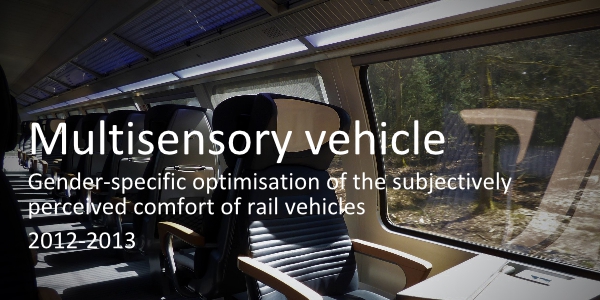Multisensory vehicle

Design and conception of a multisensory rail vehicle for the gender-specific optimisation of the subjectively perceived comfort of the respective passenger
The aim of the project was to draw up a catalogue of requirements for increasing the general attractiveness of local public transport with a special focus on the gender-appropriate design of rail vehicles in passenger transport.
Client: bmvit, FEMtech research projects 4th call for proposals
Duration: March 2016 to February 2018 (24 months)
Project partners: University of Applied Sciences St. Pölten ForschungsGmbH; TU Vienna, Institute for Transport Sciences; Interdisciplinary Research Centre for Technology, Work and Culture (IFZ); DI Dr. Michael Petz
Project advisory board: RTCA; Wiener Linien; Wiener Lokalbahnen; Siemens AG Austria; WIMEN
Project description: The aim of transport policy is to shift as much road traffic as possible to sustainable public transport. In order to generate sufficient demand in public transport, it is essential to increase its attractiveness in all areas. An increase in attractiveness leads to an increased use of the system and at the same time for all those who are already users of public transport, to noticeable increases in comfort and thus to lasting satisfaction.
In public transport, especially in rail transport, there are many factors that have a significant influence on passenger comfort, e.g. acoustic, visual or olfactory sensations in the vehicle, demands when sitting or standing in the vehicle, separation from other passengers, perception of safety, perception of temperature and much more. A significant influencing factor is the time spent on the means of transport. The aim must be to develop vehicles in which as many passengers as possible, ideally all, feel comfortable.
With regard to the diverse feel-good factors, there are gender-specific differences in particular, which are manifested in different perceptions between women and men. In order to be able to develop vehicles that provide a noticeable increase in comfort for all travellers, differentiated perception must be addressed in particular. In applied scenarios, the gender differences in the perception of and preferences for environmental characteristics are translated in such a way that both sexes can be optimally addressed. In the project, the comfort criteria, expectations and current problem areas were extensively analysed from a gender-specific, differentiated perspective and based on this, measures were developed that meet the different requirements from the perspective of women and men. The aim of the project was to develop a clear catalogue of requirements in which those requirements are clearly regulated for future vehicles that promise a corresponding increase in comfort for women and men.
Contact: Alex Schubert
